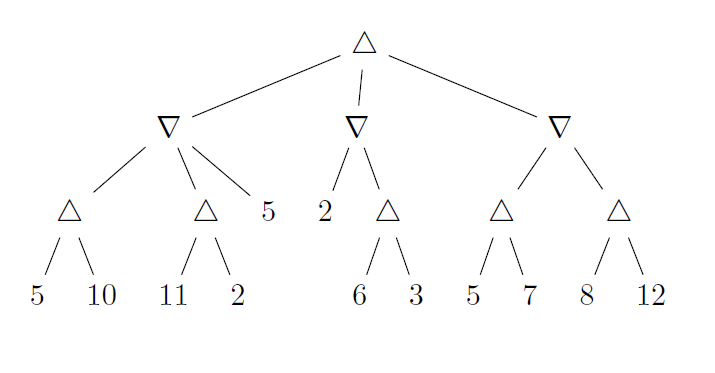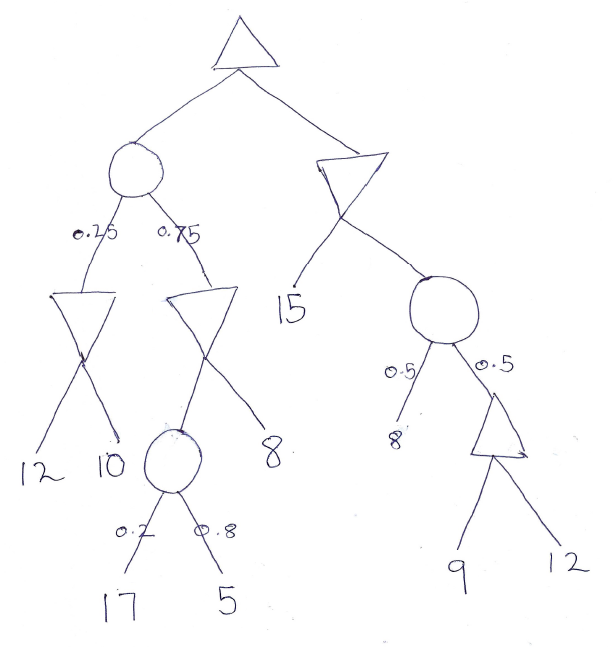Samples for Exam 2
Task 1

Figure 1: A game search tree.
a. In the game search tree of
Figure 1, if we use Minmax algorithm to find the strategy to use,
indicate the minmax values are for all the nodes. Also incidcate which
action the Minmax algorithm
will pick to exectute.
b. In the game search tree of Figure 1, indicate what nodes will be
pruned
using alpha-beta search, and what the minmax values are for
the rest of the nodes. Assume that alpha-beta
search expands nodes in a left-to-right order. Finally incidcate which
action the Minmax algorithm
will pick to exectute. Is this answer different from part a?
c. This question is also on
the game search tree
of Figure 1. Suppose we are given some additional knowledge about the
game: the maximum utility value is 12 i.e., it is not mathematically
possible for the MAX player to get an outcome greater than 12 and the
minimum utility value is 2 i.e., it is not mathematically
possible for the MIN player to get an outcome lower than 2. How can
this knowledge be used to further improve the efficiency of alpha-beta
search? Indicate the nodes that will be pruned using this improvement.
Again, assume that alpha-beta search expands
nodes in a left-to-right order.
Task 2
Suppose that you want to
implement an algorithm that will compete on a
two-player deterministic game of perfect information. Your opponent is
a supercomputer called DeepGreen. DeepGreen does not use Minimax. You
are given a library function DeepGreenMove(S), that takes any state S
as an argument, and returns the move that DeepGreen will choose for
that state S (more precisely, DeepGreenMove (S) returns the state
resulting from the opponent's move).
Write
an algorithm in pseudocode (following the style of the Minimax
pseudocode) that will always make an optimal decision given the
knowledge we have about DeepGreen. You are free to use the library
function DeepGreenMove(S) in your pseudocode. What advantage would this
algorithm have over Minimax? (if none, Justify).
Task 3

Figure 2: An Expectiminmax tree.
Find
the value of every non-terminal node in the expectiminmax tree given
above. Also indicate which action will be performed by the algoirithm.
What is lowest and highest possible outcome of a single game if the
minmax strategy is followed against an optimal opponent?
Task 4
Consider the following map.

Figure 3: Outline of a Map
The problem is to color the sections such that no two sections
sharing a border have the same color. You are allowed to use the colors
(Red, Green, Blue).
Part a: Draw
the Constraint Graph for this problem.
Part b:
Assuming you are using Backtracking search to solve this problem and
that you are using MRV with Degree heuristic to select the
variable, Which variable will be selected at each level of the search
tree [You do not need to draw the tree. Just let me know which variable
will be selected and why (MRV and degree values)]. Note: Multiple
possible correct answers. You only have to give one.
Part c: Assume you assign the color 'Red' to the
first
variable selected in part b. Show the steps involved in checking the
remaining legal values for all other variables using Arc Consistency.
Part d: Can you use structure of the problem to make
solving it more efficient?
Part e: Give one valid solution to this
problem. (You just have to give the solution. No need to give all the
steps)
Task 5
| A |
B |
C |
KB |
S1 |
| True |
True |
True |
True |
True |
| True |
True |
False |
False |
True |
| True |
False |
True |
True |
True |
| True |
False |
False |
False |
True |
| False |
True |
True |
False |
False |
| False |
True |
False |
False |
False |
| False |
False |
True |
True |
True |
| False |
False |
False |
False |
False |
KB and S1 are two propositional logic statements, that are constructed
using symbols A, B, C, and using various connectives. The above truth
table shows, for each combination of values of A, B, C, whether KB and
S1 are true or false.
Part a: Given the above
information, does KB entail S1? Justify your answer.
Part b: Given the above
information, does statement NOT(KB) entail statement NOT(S1)? Justify
your answer.
Task 6
Suppose that some
knowledge base contains various
propositional-logic sentences that utilize symbols A, B, C, D
(connected with various connectives). There are only two cases when the
knowledge base is false:
- First case: when A is true, B is false, C is true, D is false.
- Second case: when A is false, B is false, C is true, D is true.
In all other cases, the knowledge base is true. Write a conjunctive
normal form (CNF) for the knowledge base.
Task 7
Consider the KB
(A => C) AND (B <=> C) AND (D => A) AND E AND [(B AND E)
=> G] AND (B => F) AND [(H AND I)=>D] AND (E => I)
AND H
Show that this entails G (if possible) by
i. Forward Chaining
ii. Backward Chaining
iii. Resolution
Task 8
John and Mary sign the
following contract:
- If it rains on Monday, then John must give Mary a check for
$100 on Tuesday
- If John gives Mary a check for $100 on Tuesday, Mary must mow
the lawn on Wednesday.
What truly happened those days is the following:
- It did not rain on Monday
- John gave Mary a check for $100 on Tueday
- Mary mowed the lawn on Wednesday.
Part a: Write a first order logic
statement to express the contract. Make sure that you clearly define
what constants and predicates that you use are. (NOTE: DO NOT use
functions)
Part b: Write a logical
statement to
express what truly happened. When possible, use the same predicates and
constants as in
question 6a. If you need to define any new predicates or constants,
clearly define what
they stand for.
Part c: Define the symbols
required to convert any KB involved in the above
domanin from FOL to Propositional logic. Use this to convert the
answers to part a and b to Propositional Logic.
Part d:
Was the contract violated
or not, Justify your answer [Note: Contract is definitely not violated
if the events entail the contract. Contract is definitly violated if
the events entail the opposite of the contract. Unknown otherwise]
Task 9
Does a unifier exist for these
pairs of predicates. If they do, give
the unifier
i. Taller(x, John); Taller(Bob, y)
ii. Taller(y, Mother(x)); Taller(Bob, Mother(Bob))
iii. Taller(Sam, Mary); Shorter(x, Sam)
iv. Shorter(x, Bob); Shorter(y, z)
v. Shorter(Bob, John); Shorter(x, Mary)
Task 10 [Not testable material for Spring 2025]
Apply resolution to these pair of clauses if possible.
i. (NOT A(m)) OR B(x); A(x) OR C(x)
ii. B(x) OR (NOT C(m)) OR D(m); C(x) OR D(n)
iii. B(m) OR D(m); C(n) OR (NOT D(n))
